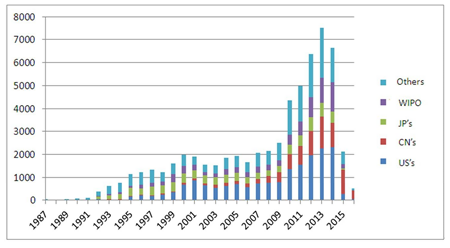Booming VR/AR Industry Needs Strong Patents as Supports
Virtual Reality (VR for short) has gradually developed into maturity and gained more and more wide attention since the 1990s. VR includes in a general sense various kinds of virtual perception like vision, audition and touch, but it focuses on virtual vision. Augmented Reality
3 (AR for short), which is dedicated to “incorporating the virtual world into the real world and making interaction between them”, is largely an innovation of the visual technique. VR and AR are therefore usually considered inseparately.
The VR/AR technology can be advantageously used in various fields such as games, entertainments, teaching, training, marketing and shopping. It has become investors’ new favorite. For instance, Facebook acquired Oculus, a pioneer of the VR/AR industry, at 2 billion US dollars. In China, similar news has always been attracting eyeballs: Xunlei invested in Deepoon VR; the Internet giant BAT set foot on the VR field.
To our pleasure, JD.COM has built its VR/AR lab by the end of this April, and on September 6 it announced that it would initiate the first “E-commerce VR/AR Alliance” and associate with more than 30 upstream and downstream enterprises to support the VR/AR industry. As stated above, the VR/AR technology is useful in a variety of fields, so it has immense estimated market value. If one counts in the related industries that are promoted by the VR/AR technology, such as shopping and games, one may expect an exponential growth in its potential economic benefit.
Intense competition, however, exists among the firms. It is reported that of the 200 VR headset companies in 2014, only 60 ones survived through 2015
4. An idea therefore comes to mind that a firm who hopes to sustainably develop has to own a large number of patents so that it turns from a capital-driven firm into a patent-driven one.
A rough investigation has been made with respect to patents in the VR/AR industry.
As a result of a statistical analysis of about 70,000 thousand related patent applications that have been published worldwide, the annual number grew steadily from the early 1990s to 2006, surpassed 1000 for the first time in 1995, kept at 1000-2000 from 1995 to 2006, exceeded 2000 in 2007, saw a steady increase for the next two years, dramatically grew from 2010 to 2013, and reached nearly 7500 in 2013. Although some applications filed after 2014 have not yet been published, it is estimated that the number will also see a steady growth after 2014, as compared with that in 2013, due to the high market heat.

As shown in the following maps, the US ranked first, followed by Japan, South Korea and China in the number of patent applications; the number of US applicatons overtook the total number of Japan’s, South Korea’s and China’s. Patents for VR/AR are primarily scattered among the US, China, Japan, South Korea and Europe. These countries/regions will become main markets for fierce competition for the future products. It is foreseeable that China’s VR/AR enterprises will be faced with patent disputes against those from the US, Japan and South Korea in the near future.

VR/AR patents are primarily in the possession of big multinational companies or big chip manufacturers such as Microsoft, Sony, Intel, Samsung, Canon, Qualcomm and Google.
Chinese applicants and 11 big multinational companies or big chip manufacturers such as Microsoft, Sony, Intel, Samsung, Qualcomm, Nokia and Canon constitute the first 20 applicants in China. Chinese applicants, however, come mainly from universities and research institutes, except for the sole enterprise Lenovo.
From the perspective of the Internatioinal Patent Classification, the VR/AR technology has, as its research focuses, virtual beings, image processing, data processing, real-time capacity, real technique and optical path system, and is primarily applied to human-body related recognition, e-commerce, educaing modelling, navigation, stereo TV system, games, human-body measurement and diagnosis on health care. China’s VR/AR industry has attached importance to the above techniques, and made intensive research and careful distribution.
There are currently 24 VR/AR patents involved in lawsuits, relating to tracing, system application, hardware and the like. The patentees include Blast Motion, Lincoln Global, Geovector, Maxus Strategic Systems, etc. A patent war, which is a war minus the shooting, is brewing. It would be best for upcoming VR/AR manufacturers to study competitors’ patents so as to avoid infringement disputes and circumvent them in their future R & D.
It would be our great honor that the above opinions are helpful to the VR/AR industry.


